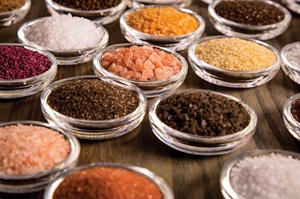Savoring the Salty Side of Life
INGREDIENTS

Some people crave sweet treats while others find salty foods irresistible. Boosting rich, delicious salty and savory tastes is more important than ever in an industry driven by flavor trends. Today, food manufacturers and culinary professionals are rethinking how they approach using ingredients that bring salty and savory tastes to food products, especially as they try to bring big flavor impact to foods while addressing clean label and health and wellness concerns of consumers. That may mean using a flavored sea salt to season potato chips or sprinkle atop chocolate truffles, yeast extracts to boost savory tastes in sauces and seasoning blends, and soy sauce and fish sauce to give both Asian and non-Asian foods umami taste. A bonus of many of these ingredients is that they help food manufacturers formulate craveable products with less sodium.
Add Distinction With Sea Salt
Sea salt has found favor among product developers and culinary professionals for its functional benefits, namely texture and flavor. “Sea salt is one of the fastest-growing market segments of the gourmet food industry,” says Jennifer Dennis, inside sales manager at SaltWorks. “The varying textures, colors, harvesting techniques, and the unique history and origin stories are the driving force behind the remarkable public response from chefs, retailers, and food enthusiasts alike.” But it’s really consumers who have increased the demand of sea salt in food products, she says. “Trend analysis shows the rate of sea salt being used across many categories is increasing quickly. Consumers are becoming savvy in reading labels, interested in quality ingredients, [and] healthier choices as well as using products that are socially and ethically responsible.”
Some consumers consider sea salt to be a better-for-you ingredient. “Cargill research has uncovered that 59% of the time, consumers believe sea salt is healthier than salt,” says Janice Johnson, food science lead at Cargill Salt. “The gap gets even larger when comparing sea salt to sodium, as consumers will consider sea salt healthier 75% of the time. What’s more, there is an extremely strong correlation between health perception and purchase impact at about 95%. The ‘health halo’ surrounding sea salt is one that actually drives consumers to actively seek it out on ingredient lists, which is great news for food manufacturers who want to find ways to serve a more health-conscious shopper.”
As consumers ask for more sea salt, food manufacturers are responding, adds Johnson. “In the last five years alone, there have been about 53,700 new product launches with sea salt, with more introduced every year.”
 Sea salt is commonly used as a finishing salt sprinkled on salads, cooked meat and fish, vegetables, snack foods like chips, and chocolate pieces, where it adds an initial bright, salty taste, crunch, and—depending on the water source—flavor and color (the flavor and color come from trace minerals and elements in sea water). Sea salt is also used in soup products, canned goods like beans, and in seasoning blends.
Sea salt is commonly used as a finishing salt sprinkled on salads, cooked meat and fish, vegetables, snack foods like chips, and chocolate pieces, where it adds an initial bright, salty taste, crunch, and—depending on the water source—flavor and color (the flavor and color come from trace minerals and elements in sea water). Sea salt is also used in soup products, canned goods like beans, and in seasoning blends.
The extensive varieties of sea salt available give food manufacturers and chefs plenty of options to customize their products and recipes by using sea salts with different colors, textures, and flavors. “Our selection of exotic salts allows manufacturers of regional foods from all over the world to keep their products authentic by offering salts from unique locations like Peru or Bolivia that are not widely offered in larger quantities,” says Dennis. “Leveraging an exotic salt in product formulation and marketing also adds a unique flair to a snack and can elevate both the consumer appeal and the flavor profile, such as potato chips made with our Ancient Ocean Himalayan Pink Salt.”
Several flavor trends are influencing the development of sea salt varieties. “Smoked salt has been emerging as a flavor trend amongst several different categories—from snack foods, confections, and seasoning blends—to add a robust smoky taste,” says Dennis. SaltWorks uses a proprietary cold-smoking process without the use of flavors, colorings, or liquid smoke to produce its smoked sea salts. The company is currently involved in relaunching its smoked salt portfolio in response to its customers’ needs and marketplace trends, says Dennis.
The earthy, umami tastes of truffles and mushrooms are popular in both food products and culinary applications, so SaltWorks developed several sea salts like white truffle salt and porcini salt that add distinctive flavors to snack mixes or to finishing and topical applications. “Truffle salt is another flavor profile that is continuing to stay strong, and our Tartufo Vero All-Natural Black Truffle Sea Salt is making an impact in the snack food category due to its clean label status.” These and other sea salt varieties in the Fusion Naturally Flavored Sea Salt line are produced using proprietary processes without the use of bonding agents, artificial flavors, or colorings, according to the company.
For those who love the added kick of heat to their foods, SaltWorks produces several Fusion Naturally Flavored Sea Salt varieties such as ghost pepper salt, sriracha salt, and habanero salt. There’s also Venom Salt made with the Trinidad scorpion pepper, which is one of the hottest chili peppers, for manufacturers who want to add a lot of heat sensation to products like spice rubs and snacks.
SaltWorks continues to explore emerging flavor trends and manufacturing needs regarding the Fusion line of flavored sea salts and may even release some new additions to the line later this year, says Dennis.
The Savory Side of Yeast
One tried and true ingredient that is a go-to for enhancing savory tastes and boosting umami and kokumi taste sensations in food products is yeast extract. Yeast extract comes in liquid, paste, and powder forms that may be easily incorporated into formulations. Quite often, very small amounts are needed to give the desired flavor impact. Other yeast-derived ingredients provide different types of savory tastes, too.
 Ajinomoto Health & Nutrition North America played a significant role in the discovery of umami (savory richness) and conducts research to better understand the richness and complexity of kokumi (rounded mouthfeel). This has led to the development of such ingredients as Savorboost. These yeast and yeast-based ingredients in the Savorboost line are said to enhance umami or kokumi taste characteristics without contributing a yeasty taste to the finished food products. Savorboost U enhances upfront umami flavor while Savorboost K brings background roundness and richness of kokumi taste sensations in savory food products. Each has less than 1% sodium, making them suitable for low-sodium formulations. Savorboost F (the F stands for full) delivers the full impact of both umami and kokumi taste sensations while Savorboost BK (for beefy kokumi) enhances kokumi taste sensations and increases beefy, roasted notes.
Ajinomoto Health & Nutrition North America played a significant role in the discovery of umami (savory richness) and conducts research to better understand the richness and complexity of kokumi (rounded mouthfeel). This has led to the development of such ingredients as Savorboost. These yeast and yeast-based ingredients in the Savorboost line are said to enhance umami or kokumi taste characteristics without contributing a yeasty taste to the finished food products. Savorboost U enhances upfront umami flavor while Savorboost K brings background roundness and richness of kokumi taste sensations in savory food products. Each has less than 1% sodium, making them suitable for low-sodium formulations. Savorboost F (the F stands for full) delivers the full impact of both umami and kokumi taste sensations while Savorboost BK (for beefy kokumi) enhances kokumi taste sensations and increases beefy, roasted notes.
In the past, Ajinomoto Health & Nutrition North America has collaborated with chefs who specialize in developing umami- and kokumi-rich product concepts featuring ingredients from the Savorboost line to educate customers about umami and spark creativity in food formulation work. Some of the product concepts the company has presented in the past highlight the versatility of the ingredients in meat dishes like lentil beef stew and in vegetarian options such as meatless burgers and vegetarian ramen.
Another ingredient that boosts the kokumi taste impact is Koji-Aji. This savory seasoning, as the company describes it, is a blend of yeast extract and fermented wheat protein. Use it to enhance the aged mature flavor and tastes of fermented foods like cheese, soy sauce, and miso, or to deliver roundness and aged character to dairy products like cheese sauces. It enriches meat flavor by providing fullness and longer-lasting taste in meat and poultry applications and brings out the cooked flavors and sweet tastes of cooked tomatoes, onions, garlic, and celery. The company also promotes Koji-Aji as a flavor enhancer in milk, where it brings out milky sweet taste, and in spice blends, where it boosts the spice flavor notes and contributes to a longer-lasting spicy note.
Biospringer’s yeast-derived ingredients include Springer 2000 yeast extracts with naturally occurring nucleotides to boost salty notes and add umami flavor and Springer 4000 yeast extracts to give foods richness and kokumi taste due to its high amount of glutathione peptides. Pronal 2000 intensifies umami taste and contributes toasted notes while Springer Standard yeast extract with savory and vegetable flavor profiles provides subtle flavors to foods. Springarom is a processed flavor ingredient derived from yeast extracts that can be used to add back or boost specific flavor notes. Finally, Springaline and Springalys are dried yeast ingredients used as flavor carriers and flavor base notes, and they also lend roasted or nutty notes to food products.
Nutritional yeast has a cheesy flavor and is used by vegans to bring cheesy, savory, and umami tastes to applications like potatoes and snack chips in place of cheese and cheese ingredients. Bio-Engevita organic nutritional yeast from Lallemand has savory, bready, and nutty flavors and is available in different toasting grades. It comes in both powder and flake formats, which can be incorporated into seasoning blends and vegetarian and vegan food products or used as a stand-alone sprinkle for salads. The ingredient’s water-binding and emulsifying properties make it a functional addition to soups, sauces, and spreads.
Biorigin starts with select strains of Saccharomyces cerevisiae to produce Bionis yeast extracts. The ingredients in the line provide savory and umami flavors and add roasted taste notes. Some are designed to help build body and mouthfeel. Derived from yeasts and yeast extracts, Biotaste ingredients are formulated to give specific taste notes such as beef, chicken, meat, and roasted. They also contribute to overall umami enhancement.
Creating a specific reaction in an extraction process allows Savoury Systems to produce yeast-based flavors that have specific flavor notes. The line features beef, turkey, pork, bacon, chicken, roast chicken, umami, brown note, and mirepoix versions. Since they are yeast-derived, they’re perfect for formulating food products geared toward vegetarian consumers (the meat, poultry, and umami are type flavors), giving the food products meaty, fatty, and smoky notes, or flavors of sugar-cured bacon or white and dark poultry meat.
 Salty Taste Enhancement
Salty Taste Enhancement
As manufacturers tweak formulas to reduce sodium, they need ingredients that help them to achieve their sodium-reduction targets without negatively affecting the taste of the finished product. That’s where an ingredient like Sensient Flavors’ SensaSalt 2G comes in.
This “taste enhancement” solution works in tandem to create the perception of a full sodium experience, boosting positive flavor attributes while diminishing off-note flavors sometimes associated with sodium reductions, says Roger Lane, marketing manager, savory flavors, at Sensient Flavors.
“That’s one of the great things about SensaSalt 2G and one of the reasons we use the term ‘taste enhancement.’ Many times, sodium reduction solutions like potassium chloride are effective in reducing sodium, but there are negative taste impacts like bitterness or other off-notes. Our product has no perceived off-notes and, in fact, actually outperforms sodium alone and enhances the positive flavor attributes of the product where it’s used.” What’s more, the ingredient has a label-friendly positioning because it can be labeled simply as “natural flavor,” adds Lane.
Another quality of the SensaSalt 2G that manufacturers may find appealing is its range of use in both wet and dry applications. Lane mentions that many sodium reduction solutions only work in either wet or dry applications, but SensaSalt 2G functions equally well in either format. Depending on the final application, the ingredient can reduce sodium by 25% to 40%. It’s been used in snack seasonings, savory sauces, soups, bakery products, and more.
The company also produces SensaSalt yeast extracts that contain high amounts of 5’ nucleotides that enhance flavors and reduce sodium levels by 33% to 50%, and Umami Natural flavor-enhancing seasoning blend of dehydrated vegetables that can boost flavor without adding salt.
 Asian Sauces Intensify Umami Taste
Asian Sauces Intensify Umami Taste
Singular ingredients like sea salt and yeast extracts are popular options for adding salty and savory tastes to foods, but sauces, particularly those used in Asian cuisine, are key flavor enhancers, too. Intensely flavored sauces, such as fish, soy, and oyster, are high in amino acids that give the savory/umami tastes to foods and are used as finishing sauces, condiments, and flavor enhancers. Huynh et al. (2016) published a study in Journal of Food Science in which the researchers demonstrated that fish sauce may be used as a partial substitute for salt in food products without negatively affecting sensory properties. Naturally brewed soy sauce, for example, is high in glutamic acid, which contributes to umami taste and works in synergy with salt to enhance the umami taste even more. In a Journal of Food Science review article, Lioe et al. (2010) write that free L-glutamic acid and other free amino acids may interact with other tastants to elicit umami taste in soy sauce.
Long cooking times produce rich, meaty flavors such as in a stew or soup prepared by a home cook, but food manufacturers producing processed food products often follow a more rapid production schedule. Adding just a little soy sauce to formulas can lend some of these rich savory flavors to processed food products. Kikkoman Sales USA produces a variety of soy sauce products as well as other full-flavored savory sauces that boost umami taste in both Asian and non-Asian food products.
Soy sauce has been an important ingredient in Asian cooking for centuries, and now it’s used to provide richness, flavor depth, and aroma to many non-Asian applications like cheese items, snack foods, jerky, frozen meals, dressings, sauces, gravies, cured meats, chocolate syrups and coatings, and baked goods. There are also gluten-free and lower-sodium versions of soy sauce and tamari soy sauce, including Kikkoman Less-Sodium, Gluten-Free Non-GMO Tamari Soy Sauce with 40% less sodium than regular gluten-free tamari soy sauce.
Other Kikkoman sauces like katsu sauce, a combination of apples, onions, tomato paste, and soy sauce, and teriyaki sauce, made from soy sauce, vinegar, sweetener, and seasonings, not only provide savory flavors to foods but also a bit of sweetness. For use in applications where a liquid sauce just won’t work, there are dehydrated and granulated soy sauce ingredients that easily incorporate into seasoning blends, snack food coatings, concentrated soup bases, and powdered mixes. Kikkoman’s dehydrated and granulated soy sauce ingredients are produced through a spray-drying method. The free-flowing powders have demonstrated flavor retention during heat processing and freezing and can be easily reconstituted in water.
Reduce Sodium, Keep Salty Taste
Any mention of salt, and of its functional purposes, often turns into a discussion of how to reduce the use and consumption of this ingredient. Consumers, nutrition bloggers and activists, health experts, and regulators are all prompting food manufacturers to reformulate products to have less sodium, says Johnson of Cargill Salt. “We know that in the last five years, 20,630 low sodium–positioned products have been launched into the market. This is one of many indications that companies are actively and rapidly working to reduce sodium in their foods.”
Regulators in the United States, European Union, and other countries around the world have taken steps to influence the formulation efforts of food manufacturers and encourage consumers to reduce their intake of salt. For example, the World Health Organization recommends reducing sodium intake to less than 2 g/day, while various European countries have instituted sodium reduction policies and initiatives in recent years. “The USDA’s Dietary Guidelines for Americans 2015–2020 recommend a maximum sodium intake of 2,300 mg per day—and even lower in the presence of certain medical conditions and above the age of 51,” says Simone Bouman, senior industry director of sweet & savory food at Corbion. “But nine out of 10 consumers exceed that level. In fact, the average intake is nearly 50% higher, at 3,400 mg. Two-thirds of this comes from food bought in stores, according to the Centers for Disease Control, so clearly our industry has a huge responsibility for reformulating and helping Americans eat more healthily.”
Salt not only imparts a distinctive salty taste, it also enhances flavor in sauces, soups, meats, breads, and ready meals, “applications that will have less balanced and pronounced flavor if sodium is reduced and not counterbalanced by alternatives that will optimize taste again,” says Bouman. “Consumers understand that lower sodium is healthy, but they don’t want to sacrifice taste in pursuit of that goal.”
Food manufacturers are challenged to have meaningful reductions in sodium without adversely affecting the taste of the product. Campbell’s Soup in 2011 had to backtrack on its sodium reduction efforts for one of its lines of soup products by adding back some of the sodium and including flavors and seasoning after receiving customer feedback to improve the taste of the soup. “Compromised taste was the main issue in the Campbell’s Soup example but, of course, sodium has other roles in other products, including controlling water activity, water binding, texture optimization, preservation, and more,” says Bouman. “Any reduction in sodium levels necessitates a corresponding adjustment elsewhere in the recipe to retain those functionalities as far as possible.”
This means that reducing sodium will require reformulating, testing, and optimizing to make sure enough sodium is reduced while consumers are still satisfied with the taste and texture of the product, says Bouman. Both Bouman and Johnson say that food manufacturers are finding success in employing the so-called stealth health approach in sodium reduction. This refers to the gradual and unannounced reduction of sodium levels to give consumers’ palates time to get accustomed to the changes in the flavor profile, says Bouman. By doing this, manufacturers can reach their sodium reduction goals and maintain, and maybe even expand, their consumer base, says Johnson. “The regular purchasers who don’t check the Nutrition Facts Panel won’t know the difference, and the consumers who do check on sodium levels may be more satisfied with the lower inclusion rates.”
Corbion’s portfolio of sodium reduction solutions features natural flavors such as PuraQ Arome NA4, which help to enhance salty tastes and overall flavor. “These ingredients are based on fermentation of natural and sustainable crops, and we have been able to create a variety of natural flavors tailored for different applications,” says Bouman. “But it’s not only in the area of taste that we can help. Sodium has an important role in food safety and shelf life in applications like ready meals, meat, etc. To retain safety and preservative properties in low-sodium foods, Corbion also provides ingredient solutions that ensure safety, enhance freshness, and prolong shelf life.”
References
Huynh, H. L., R. Danhi, and S. W. Yan. 2016. “Using Fish Sauce as a Substitute for Sodium Chloride in Culinary Sauces and Effects on Sensory Properties.” J. Food Sci. 81(1): 150–155.
Innova. 2018. “Top Ten Trends 2019.” Dec. 4. https://www.foodingredientsfirst.com/webinars.html.
Lioe, H. N., J. Selamat, and M. Yasuda. “Soy Sauce and Its Umami Taste: A Link from the Past to Current Situation.” J. Food Sci. 75(3): 71–76.
Nikken. 2019. “The Best Savory Snack Trends of 2019. April 22. https://www.nikkenfoods.com/category/blog/.


